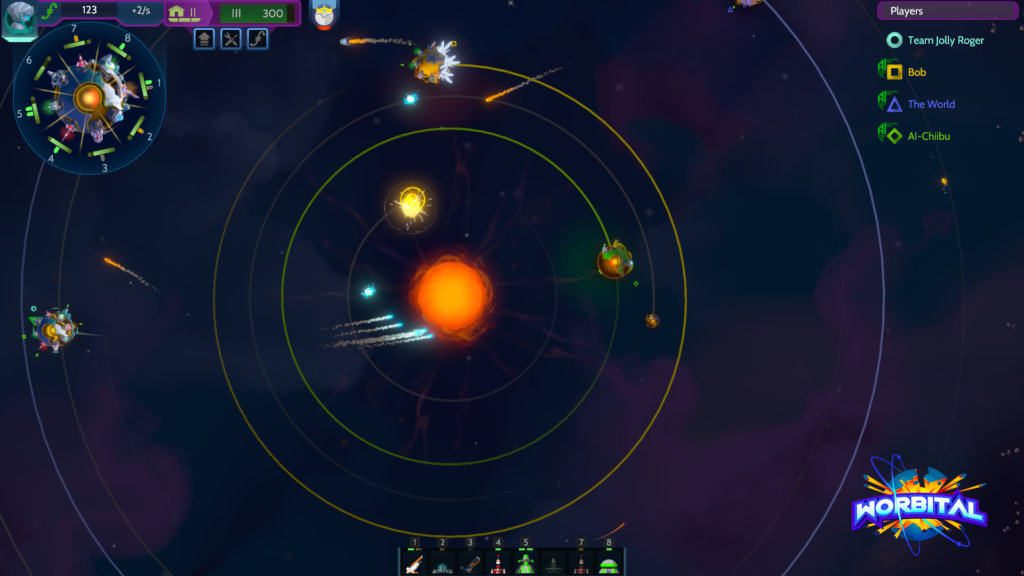Worbital (PC)
 The folks that brought you Worms have entered the space race. Load your planet with offense and defense and attack your opponents in a real-time battle of planetary destruction in a evolving planetary system. Worbital is an interesting take on the old fixed artillery battle mold, increasing the intensity through real-time control and gravity wells from the central sun and orbiting planets. It is a great multiplayer game, but has a bit of a UI learning curve.
The folks that brought you Worms have entered the space race. Load your planet with offense and defense and attack your opponents in a real-time battle of planetary destruction in a evolving planetary system. Worbital is an interesting take on the old fixed artillery battle mold, increasing the intensity through real-time control and gravity wells from the central sun and orbiting planets. It is a great multiplayer game, but has a bit of a UI learning curve.
In Worbital, each player controls a planet orbiting a central star. Each planet has its own orbital radius (some nearer, some farther from the star) and planets may orbit clockwise or counter clockwise, so targets are constantly moving. Players attack each other (and unoccupied planets) in order to destroy the enemies’ planet, earning cash along the way for damage given and damage taken. Heavy bombardments also destroy a planet’s buildings, and make it even easier to go in for the kill.
 Each planet holds 8 building slots surrounding a planet, essentially making an octagon of locations which can be loaded up with offense, defense, or other special structures. Most buildings hold one or more charges, which are consumed when used and recharge over time. Standard attacks consist of projectiles affected by the gravity well of all the objects on the screen. When aiming projectiles, a handy path is displayed on the board that estimates the likely path of the projectile. However, it doesn’t take into account movement of planets, so longer shots need a bit of precision aiming. Other attacks include straight-line laser beams, homing projectiles, and even steerable ships and nukes. Successful hits damage the other player’s buildings and earn cash which can be used for further construction. Players need to wait for buildings to recharge, but since each planet is also rotating on its axis, a player’s own planet is frequently in the way of a shot. Managing weapons/beams/defensive buildings is a mix of waiting for recharge timers as well as the appropriate planet facing. Defensive buildings tend to have localized effects, such as a short burst of scattershot that destroys incoming missiles or a planetary shield that blocks nearly all sources of damage. Defense is not 100% damage proof as they have their own recharge timers, and only affect one side of the planet at a time. Some of the “other” building effects include refineries (generate money), jets to move one’s planet around, the ability to “colonize” other planets, or drop off an automatically controlled gun emplacement on a passing empty planet.
Each planet holds 8 building slots surrounding a planet, essentially making an octagon of locations which can be loaded up with offense, defense, or other special structures. Most buildings hold one or more charges, which are consumed when used and recharge over time. Standard attacks consist of projectiles affected by the gravity well of all the objects on the screen. When aiming projectiles, a handy path is displayed on the board that estimates the likely path of the projectile. However, it doesn’t take into account movement of planets, so longer shots need a bit of precision aiming. Other attacks include straight-line laser beams, homing projectiles, and even steerable ships and nukes. Successful hits damage the other player’s buildings and earn cash which can be used for further construction. Players need to wait for buildings to recharge, but since each planet is also rotating on its axis, a player’s own planet is frequently in the way of a shot. Managing weapons/beams/defensive buildings is a mix of waiting for recharge timers as well as the appropriate planet facing. Defensive buildings tend to have localized effects, such as a short burst of scattershot that destroys incoming missiles or a planetary shield that blocks nearly all sources of damage. Defense is not 100% damage proof as they have their own recharge timers, and only affect one side of the planet at a time. Some of the “other” building effects include refineries (generate money), jets to move one’s planet around, the ability to “colonize” other planets, or drop off an automatically controlled gun emplacement on a passing empty planet.
Players must choose a race to use within the game. While some buildings are common to all, each race has some buildings that grant them unique abilities, like the aforementioned ability to move one’s planet. The races also tie into an in-game currency (essentially experience points) earned by playing the game and its campaign mode. Each race has its own campaign mode and spending points to unlock a race’s special buildings also opens up additional buildings to unlock.
The game can be played against computer opponents, online opponents (through matchmaking), or a mix of the two. It can be an everyone-for-themselves affair or played in teams. I always enjoy teaming up with a friend and taking on a few more challenging computer opponents.

Verdict
I’m a fan of the turn-based artillery games (popularized by Scorched Earth and more recently, the Worms franchise) so it was interesting to see a new take on the genre. Selecting a weapon turns the mouse pointer into a prediction of the launch path for the weapon. So, unlike some games of its type, player skill does not focus on estimating launch angle. Instead, players need to focus on more real-time tasks such as constructing buildings and staying on top of when one’s weapons will rotate into position. I found the experience to be unique and engaging. However, there is a lot going on in the game and while I could stay on top of most of the things I was hoping to accomplish, the user interface was often my enemy rather than my friend. Offensive weaponry is fairly simple to manage, launching weapons whenever they are charged up or simply checking back on them every few seconds to see if a new weapon has rotated ino range (queue any of several scenes from Star Wars’ Death Stars.) However, a planet without any defenses is not going to last very long, and I found this to be the most challenging part of the game. Defenses need to be timed so that they kick in just before a weapon detonates on the planet, but they only cover one side of the planet so one needs to manage both timing and selection of the defensive building. Here the user interface failed me. Each planetary slot is assigned a hotkey 1 to 8. Clicking on the number instantly queues up that building. Choosing an empty slot brings up a quick-build menu that lets you instantly select a new building to construct. However, if I chose the wrong number and bring up an empty building slot, hitting the correct number doesn’t change to the correct building – it queues up a new building in the queue for the current slot. It is small things like this in the user interface that made the experience frustrating, even after four or five games. While the steep learning curve of the user interface can be frustrating, the underlying game is quite fun. The campaign modes, multiplayer options and progressive unlockable “special powers” keep the game interesting in the long run.
Kid Factor:
No maturity issues here… lots of cool explosions and other effects but there’s a complete lack of any human element so death and destruction is of buildings and planets only. The UI may be challenging for younger players, and there is a lot going on – but once past that learning curve the game is very approachable for pre-teens or even a bit younger.





Discussion Area - Leave a Comment